11 Examples of SaaS Pricing Done Right
11 Examples of SaaS Pricing Done Right
11 Examples of SaaS Pricing Done Right
Learn how to nail your SaaS pricing strategy with these eleven examples of companies that have got it right!
Learn how to nail your SaaS pricing strategy with these eleven examples of companies that have got it right!
Learn how to nail your SaaS pricing strategy with these eleven examples of companies that have got it right!



Does it feel like it’s impossible to get your SaaS pricing strategy right? 😰We won’t deny that it does feel pretty overwhelming…

However, there are many SaaS companies that have priced their products successfully!
And you can take a leaf or two from their playbook!
Let’s look at some things you can do to work on your pricing strategy and what other SaaS companies have got right.
Let’s dive right in!
Let’s go!
Get your Positioning Right 🎯
You need to get your positioning right, to get to the right pricing strategy.
Here’s why:
· Increased customer loyalty
· Consistent sales
· Having an edge over competitors
So how do you go about it?
1. Understand your target customer’s pain point ⚠️
You can’t have a successful SaaS product if no one needs it.
That’s why figuring out your target customer’s pain point is crucial.
Feel their pain like it’s your pain…
You’ll be able to understand what customers need to solve their problems and offer them good functionality.
You can position the value of your product accordingly and market it as the best possible solution to their pain point!
2. Identify and analyze the competition 🧐
You can’t have a successful SaaS product if potential customers choose your competition over you.
Find out who your direct competitors are. What are they doing better than you?
Analyzing the competition will help you figure out what you can improve and shift your value proposition to market your product to be chosen over your competitors.
3. Experiment with pricing 👀
Trial and error ftw
You’ll only improve if you test different strategies and learn from the results, good or bad!
Doing quick pricing experiments is how you’ll improve faster and get your positioning right.
Experiment Fast to Improve Faster 🙌🏼
Pricing is the key to your entire SaaS business – but it can be pretty tricky and overwhelming to pin down and find what actually works for you.
You don’t want to end up like this guy…

Pricing experiments will help you to get a lot of real-time ⏱️ feedback on what pricing strategies your customers are responding to better.
Keep these things in mind before you consider starting with pricing experiments:
·Marc Boscher, Founder & CEO of Unito – who ran pricing experiments for Unito – suggests that your company should be bringing in a minimum of 100 new customers/month to make A/B testing work well for you.
·Before you start your pricing experiments, you need to do enough risk modeling and a few cycles of research-survey analysis.
·Make sure your sample size is generally indicative of what your entire customer base would do – otherwise, your results could mislead you.
To get started, here are the three core things you can run pricing experiments for:
·The price point
·Feature differentiation: The packaging for your tiers or plans
·Your value metric: What exactly do you charge for?
You need to then track metrics that your SaaS business is looking to improve upon.
Here are some of the standard metrics that companies like Klipfolio and Unito have used:
·Conversion rates
·Average sale price
·Average subscription value
·Number of users per account
·Short-term net revenue retention
·Customer behavior
We’ve got a more in-depth article on running pricing experiments right here – check it out!
Now let’s take a look at 11 SaaS companies that have absolutely nailed their pricing!
Eleven SaaS companies that got their pricing right 🚀
1. AppCues
AppCues provides captivating product onboarding experiences to customers with their no-code platform through which you can track and evaluate usage data and create guided tours, surveys, and more.
They have a hybrid Saas pricing model that mixes tiered and per-active-user pricing (measuring monthly active users).
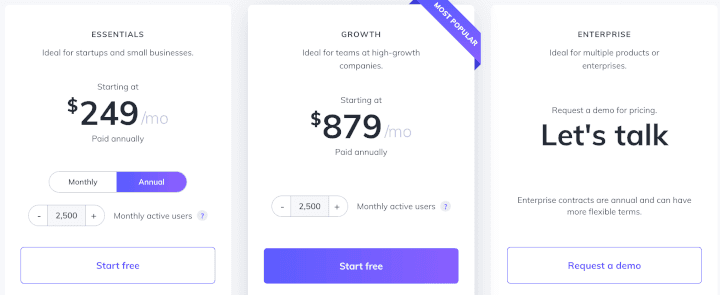
They’ve also mapped out their customer journey through their three tiers, meant for three different points in any company’s scaling process: small businesses, high-growth companies, and enterprises.
Their pricing is straight to the point, perfectly tailored to their customer needs, and value-based, with their least expensive plan starting at $249/month.
What’s more, they’ve been a fast-growing company that has landed clients like Hotjar, ProfitWell, GetResponse, and Litmus – and a Series B funding of over $32M
2. Drift
Drift has generated a lot of value for a relatively young company – founded in 2015, the company’s present valuation is $11.3M! They’re a company that uses conversational sales and marketing to help companies with revenue acceleration.
They’ve grown immensely in seven years – they now have over 50K customers, including big clients like Adobe, GitHub, Canva, and Atlassian.

Following in the footsteps of Slack’s ‘fair billing’ messaging, Drift decided to make two important pricing moves:
·They opened up a free plan for users to try out the platform
·They switched their pricing model to per-active-user to provide fair value to their customers and reduce their churn rates.
Beyond their free plan, they offer three basic paid tiers for small, medium-sized, and large businesses – and they direct you to an AI chatbot if you want to learn more about any of the plans!
Drift believes in value-based pricing for their target market, and they claim a 670% ROI and a 100% increase in lead-to-pipeline conversion rates with the services they offer!
With success rates like this, they’re doing a lot of things right – and their pricing strategy is definitely one of them! 😎
3. Close
Close is a Customer Relationship Management (CRM) service targeted mainly at startups and small businesses.
They’ve been around since 2013, and they’ve managed to work with companies like ChartMogul, Toggl, Zapier, and NatureBox.
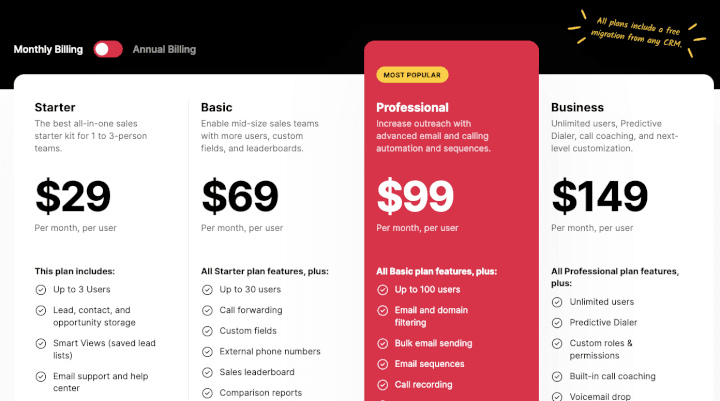
Close deploys a hybrid pricing model:
·Simple tiered pricing model with four need-based tiers
·Per-feature pricing model where they provide new features and professional CRM services as add-ons, such as onboarding, data clean-ups, and sales operations.
Close also offers a few freebies in good faith:
·Free 14-day trial with no credit card required
·Free custom data migration from any other CRM tool
·Free resources like a Startup Sales Bundle and a directory of sales consultants
And they’ve also got their positioning right with their target audiences listed on their website for anyone to come across:
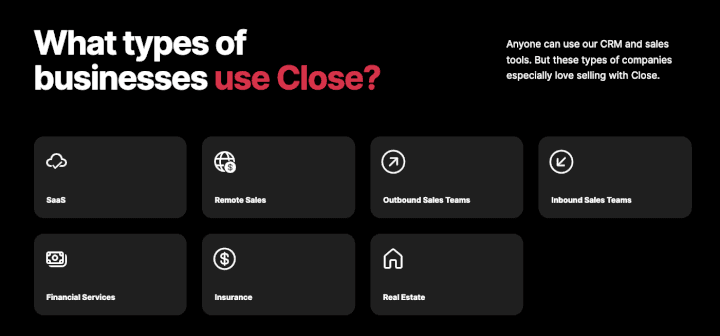
Close has certainly got its pricing right with the correct positioning, simple and relatively inexpensive plans, and add-on CRM services.
4. Salesforce
A ‘force’ to be reckoned with, Salesforce is an industry veteran that’s been around since 1999 and, in 2020, was crowned as the largest SaaS vendor worldwide.
By 2021, they managed to take over 23.8% of the global CRM applications market with their plethora of products sorted by need and industry.
It’s safe to say that Salesforce has been one of the pioneers of SaaS pricing strategy.
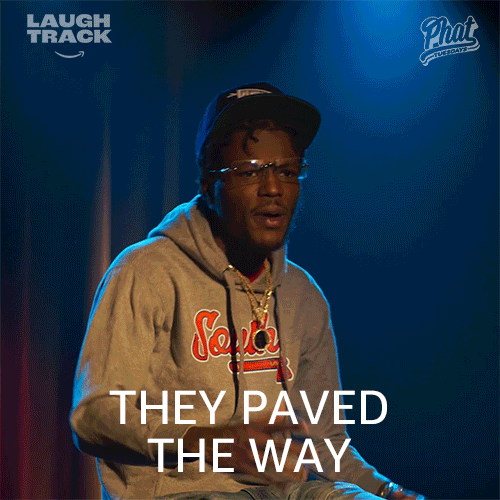
Around 2013, they ran A/B tests on their pricing pages to compare the performance between a four-tier pricing model and a five-tier pricing model – they eventually chose the five-tier pricing model at the time.
In 2015, they decided to revamp their entire look by rolling out the Lightning experience – and we still see the blue/white color scheme they adopted on their pricing pages today!
Beyond these internal changes, Salesforce gained more revenue and market share and developed many new products by acquiring many other SaaS companies like Slack, Acumen, and Tableau.
5. Agorapulse
Agorapulse is an all-in-one social media management program for everyone ranging from the average individual to a large, multinational company.
This SaaS company has also adopted a hybrid pricing model:
·Tiered pricing: Four simple tiers ranging from Free to Custom for Enterprise, based on the number of social profiles and users
·Per-Feature pricing: Add-on services like Power Reports, Shared Calendars, and Facebook Competitor Report.
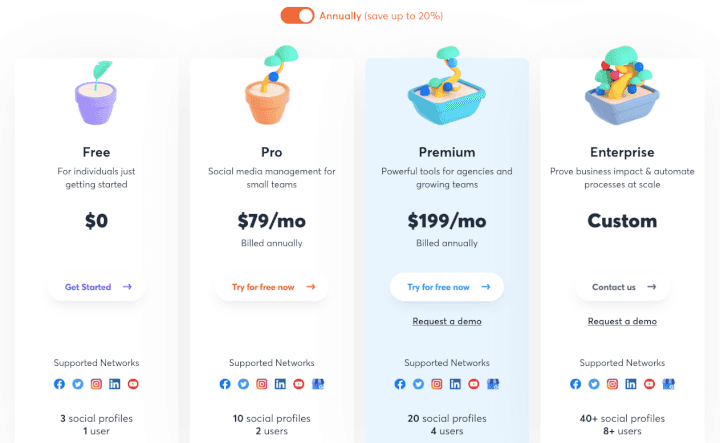
They’ve also cleverly mapped out their customer journey through tiers, meant for four different levels of scale – plus, they offer both a freemium model and a free trial model. Their pricing model is simple, affordable (when compared to competitors), and clearly working for them.
With their successful market positioning and pricing, Agorapulse has landed incredible clients like Ogilvy, Confluent Health, Digital Butter, and West Virginia University.
6. HubSpot
Another industry veteran, HubSpot, is a CRM and inbound marketing software. As of May 2021, it’s the top marketing automation solution worldwide, reportedly used by 29.5% of customers.
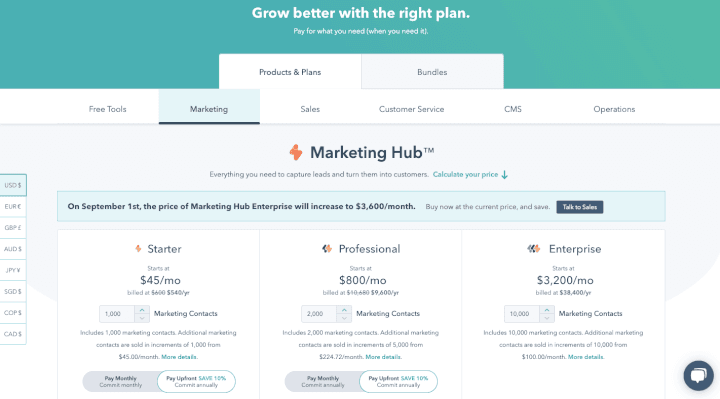
Their pricing strategy may seem complicated, but there are many things they’re doing right:
·Increasing their price point for the Marketing Hub Enterprise tier with a notification on the pricing page
·Five separate products (Hubs) so customers can pick and choose
·Each hub has its own pricing metrics – Marketing Contacts, per-user pricing model, or for a set of features
·Hyper-personalized pricing plans with a ‘Calculate your price’ option to help customers figure out what they need
·Pricing page available universally in 8 different currencies
·Bundled pricing with the full CRM Suite or customization with ‘Create a Bundle’ so clients can pick and choose
·Freemium pricing model provides access to some tools for free
It’s clear that the people at HubSpot have put a lot of thought into its pricing page. With this level of customization, they cover all bases and ensure that the plan you choose is perfectly tailored to your needs.
And they have a plan and a price for every stage of customer growth, starting from a low price of $45/month all the way up to $3200/month.
With high-profile clients like Reddit, Loom, SoundCloud, and The Linux Foundation, it’s no wonder that HubSpot is the most successful marketing automation software out there.
You could say HubSpot is kind of magical that way…

7. DocuSign
Founded in 2003, DocuSign’s primary product is the Agreement Cloud – a cloud-based software that offers agreement automation and lets you add legally binding e-signatures to all of your documents.
DocuSign has been around for a long time, and they’ve got giant multinational clients like Apple, Unilever, Aon, and AstraZeneca.
Despite its relatively simple pricing pages, DocuSign still dominates the e-signature software market with around 65% of the market share.
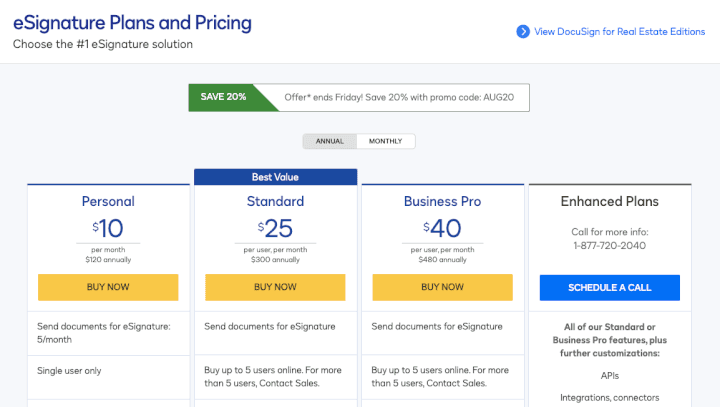
Here are a few things DocuSign is doing right with their pricing:
·Basic freemium offering
·Three public pricing plans: eSignature, eSignature for Real Estate, and API Usage plans
·Each pricing plan is a hybrid model of tiered and per-user pricing
·Only a ‘Talk to Sales’ option without a pricing page for their enterprise-level products like Contract Lifestyle Management and Electronic Notarization – so that enterprise-level clients have a personalized sales experience
Many competitors to DocuSign have come up in the past decade. However, DocuSign still seems to be the leading choice for most of the industry – and it’s easy to see that their robust competitor pricing strategy and high-value products have been super successful!
8. Atlassian
Atlassian is a tech giant founded in 2002, and it’s a business software company that creates tools like Jira and Trello to help companies with project management, team collaboration, and more.
If you check out the Atlassian website now, you’ll realize that the company has created and acquired many products, and all have different SaaS pricing models. Some are tiered, some are user-based, some are pay-as-you-go, and some are hybrid models.
But regardless of how successful Atlassian is now, they’ve maintained the freemium + free trial model that helped them with upselling to customers without a large sales team ever since 2002. This model has also kept their customer acquisition cost (CAC) low.
Beyond this simple pricing strategy, Atlassian began acquiring other SaaS companies and integrated those products into their software. The aim of this business model was to optimize the company’s focus to fill gaps in Atlassian’s offerings by expanding rather than building more software by themselves.
9. MailChimp
MailChimp is a veteran email marketing software that was founded in 2001. Financial software giant Intuit acquired the company in November 2021 – and there have been a few changes to MailChimp’s structure since then.
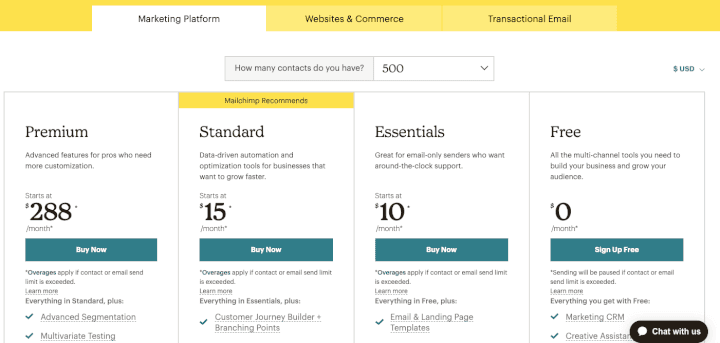
MailChimp’s original marketing product is now made up of four tiers instead of the original three. Apart from this, there are now two more products: Websites & Commerce and Transactional Email.
For Q3 of FY22, Intuit’s total revenue grew to $5.6 billion (up by 35%) – and this includes MailChimp’s third quarter revenue of $257 million. Strategic pricing ftw!
10. Canva
At this point, we’ve all used Canva at least once – whether for making a social media creative, a beautiful presentation, a cool flyer, a clean resume, or pretty much anything else.
This Australian online graphic design software, founded in 2012, has really taken off in the past few years.
Their product pricing plan has also evolved over the years. Around 2019, Canva had a simple flat-rate pricing model (like Basecamp) with Canva Free and a single Canva Pro plan at $12.95/month.
They’ve now upgraded that pricing model to match their growing user base:
·Three tiers: Canva Free, Canva Pro, and Canva for Teams
·The Pro plan is still there – but it’s now just for one person and at a slightly higher price of $12.99/month
·Canva for Teams is for teams of all sizes
·Teams offers per-user pricing, from $14.99/month for up to 5 team members to custom pricing for teams larger than 50 people
By streamlining its pricing by use case, Canva has done a lot for its own growth.
The proof is in the pudding:
Canva now has over half a million teams paying for their product in some capacity – with big names like Zoom, Marriott, and Lonely Planet among their customer base – and was expected to exceed $1 billion in annualized revenue by the end of 2021.
11. Productboard
Productboard is a product management software founded in 2014.
Today, they’ve got over 6,000 companies as customers – including SaaS superheroes like Zoom and Zendesk!
Productboard has a unique pricing structure that takes different buyer personas into account: it’s technically four pricing tiers, but it’s designed to look like two tiers that each have two tiers below them. Have a look:
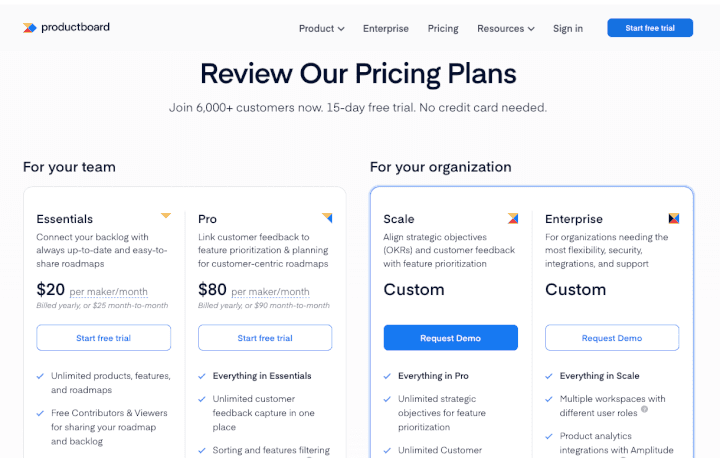
Here’s why this was a great idea:
·The first level is for company size, and the second is for needs: To some extent, this may eliminate a customer’s decision fatigue from considering four choices to just two choices
·This allows Productboard to have two basic premium plans and gives them the flexibility of custom pricing for two different need-based enterprise plans
On top of this, they offer a 15-day free trial with no credit card needed – a helpful way to reel customers in and let them test the waters without the risks of offering a fully freemium option.
… and with that, our list is complete.
Key Takeaways
Let’s do a quick recap:
·Understanding your customer’s pain point and knowing your competition well is everything!
·Run pricing experiments! It’s the best way to get real-time feedback on your pricing strategy.
·Be careful: Take calculated risks!
·One of the best ways to learn and be inspired is to look at the pricing success stories of other SaaS companies!
Once you’re confident about being able to price intelligently – you can use Toplyne to convert leads effortlessly! 😎
If you’re even a little more ready to face SaaS pricing than you were before, our work here is done.
Sign up for Toplyne for free today to make the impossible possible! 🦸
Does it feel like it’s impossible to get your SaaS pricing strategy right? 😰We won’t deny that it does feel pretty overwhelming…

However, there are many SaaS companies that have priced their products successfully!
And you can take a leaf or two from their playbook!
Let’s look at some things you can do to work on your pricing strategy and what other SaaS companies have got right.
Let’s dive right in!
Let’s go!
Get your Positioning Right 🎯
You need to get your positioning right, to get to the right pricing strategy.
Here’s why:
· Increased customer loyalty
· Consistent sales
· Having an edge over competitors
So how do you go about it?
1. Understand your target customer’s pain point ⚠️
You can’t have a successful SaaS product if no one needs it.
That’s why figuring out your target customer’s pain point is crucial.
Feel their pain like it’s your pain…
You’ll be able to understand what customers need to solve their problems and offer them good functionality.
You can position the value of your product accordingly and market it as the best possible solution to their pain point!
2. Identify and analyze the competition 🧐
You can’t have a successful SaaS product if potential customers choose your competition over you.
Find out who your direct competitors are. What are they doing better than you?
Analyzing the competition will help you figure out what you can improve and shift your value proposition to market your product to be chosen over your competitors.
3. Experiment with pricing 👀
Trial and error ftw
You’ll only improve if you test different strategies and learn from the results, good or bad!
Doing quick pricing experiments is how you’ll improve faster and get your positioning right.
Experiment Fast to Improve Faster 🙌🏼
Pricing is the key to your entire SaaS business – but it can be pretty tricky and overwhelming to pin down and find what actually works for you.
You don’t want to end up like this guy…

Pricing experiments will help you to get a lot of real-time ⏱️ feedback on what pricing strategies your customers are responding to better.
Keep these things in mind before you consider starting with pricing experiments:
·Marc Boscher, Founder & CEO of Unito – who ran pricing experiments for Unito – suggests that your company should be bringing in a minimum of 100 new customers/month to make A/B testing work well for you.
·Before you start your pricing experiments, you need to do enough risk modeling and a few cycles of research-survey analysis.
·Make sure your sample size is generally indicative of what your entire customer base would do – otherwise, your results could mislead you.
To get started, here are the three core things you can run pricing experiments for:
·The price point
·Feature differentiation: The packaging for your tiers or plans
·Your value metric: What exactly do you charge for?
You need to then track metrics that your SaaS business is looking to improve upon.
Here are some of the standard metrics that companies like Klipfolio and Unito have used:
·Conversion rates
·Average sale price
·Average subscription value
·Number of users per account
·Short-term net revenue retention
·Customer behavior
We’ve got a more in-depth article on running pricing experiments right here – check it out!
Now let’s take a look at 11 SaaS companies that have absolutely nailed their pricing!
Eleven SaaS companies that got their pricing right 🚀
1. AppCues
AppCues provides captivating product onboarding experiences to customers with their no-code platform through which you can track and evaluate usage data and create guided tours, surveys, and more.
They have a hybrid Saas pricing model that mixes tiered and per-active-user pricing (measuring monthly active users).

They’ve also mapped out their customer journey through their three tiers, meant for three different points in any company’s scaling process: small businesses, high-growth companies, and enterprises.
Their pricing is straight to the point, perfectly tailored to their customer needs, and value-based, with their least expensive plan starting at $249/month.
What’s more, they’ve been a fast-growing company that has landed clients like Hotjar, ProfitWell, GetResponse, and Litmus – and a Series B funding of over $32M
2. Drift
Drift has generated a lot of value for a relatively young company – founded in 2015, the company’s present valuation is $11.3M! They’re a company that uses conversational sales and marketing to help companies with revenue acceleration.
They’ve grown immensely in seven years – they now have over 50K customers, including big clients like Adobe, GitHub, Canva, and Atlassian.

Following in the footsteps of Slack’s ‘fair billing’ messaging, Drift decided to make two important pricing moves:
·They opened up a free plan for users to try out the platform
·They switched their pricing model to per-active-user to provide fair value to their customers and reduce their churn rates.
Beyond their free plan, they offer three basic paid tiers for small, medium-sized, and large businesses – and they direct you to an AI chatbot if you want to learn more about any of the plans!
Drift believes in value-based pricing for their target market, and they claim a 670% ROI and a 100% increase in lead-to-pipeline conversion rates with the services they offer!
With success rates like this, they’re doing a lot of things right – and their pricing strategy is definitely one of them! 😎
3. Close
Close is a Customer Relationship Management (CRM) service targeted mainly at startups and small businesses.
They’ve been around since 2013, and they’ve managed to work with companies like ChartMogul, Toggl, Zapier, and NatureBox.

Close deploys a hybrid pricing model:
·Simple tiered pricing model with four need-based tiers
·Per-feature pricing model where they provide new features and professional CRM services as add-ons, such as onboarding, data clean-ups, and sales operations.
Close also offers a few freebies in good faith:
·Free 14-day trial with no credit card required
·Free custom data migration from any other CRM tool
·Free resources like a Startup Sales Bundle and a directory of sales consultants
And they’ve also got their positioning right with their target audiences listed on their website for anyone to come across:

Close has certainly got its pricing right with the correct positioning, simple and relatively inexpensive plans, and add-on CRM services.
4. Salesforce
A ‘force’ to be reckoned with, Salesforce is an industry veteran that’s been around since 1999 and, in 2020, was crowned as the largest SaaS vendor worldwide.
By 2021, they managed to take over 23.8% of the global CRM applications market with their plethora of products sorted by need and industry.
It’s safe to say that Salesforce has been one of the pioneers of SaaS pricing strategy.

Around 2013, they ran A/B tests on their pricing pages to compare the performance between a four-tier pricing model and a five-tier pricing model – they eventually chose the five-tier pricing model at the time.
In 2015, they decided to revamp their entire look by rolling out the Lightning experience – and we still see the blue/white color scheme they adopted on their pricing pages today!
Beyond these internal changes, Salesforce gained more revenue and market share and developed many new products by acquiring many other SaaS companies like Slack, Acumen, and Tableau.
5. Agorapulse
Agorapulse is an all-in-one social media management program for everyone ranging from the average individual to a large, multinational company.
This SaaS company has also adopted a hybrid pricing model:
·Tiered pricing: Four simple tiers ranging from Free to Custom for Enterprise, based on the number of social profiles and users
·Per-Feature pricing: Add-on services like Power Reports, Shared Calendars, and Facebook Competitor Report.

They’ve also cleverly mapped out their customer journey through tiers, meant for four different levels of scale – plus, they offer both a freemium model and a free trial model. Their pricing model is simple, affordable (when compared to competitors), and clearly working for them.
With their successful market positioning and pricing, Agorapulse has landed incredible clients like Ogilvy, Confluent Health, Digital Butter, and West Virginia University.
6. HubSpot
Another industry veteran, HubSpot, is a CRM and inbound marketing software. As of May 2021, it’s the top marketing automation solution worldwide, reportedly used by 29.5% of customers.

Their pricing strategy may seem complicated, but there are many things they’re doing right:
·Increasing their price point for the Marketing Hub Enterprise tier with a notification on the pricing page
·Five separate products (Hubs) so customers can pick and choose
·Each hub has its own pricing metrics – Marketing Contacts, per-user pricing model, or for a set of features
·Hyper-personalized pricing plans with a ‘Calculate your price’ option to help customers figure out what they need
·Pricing page available universally in 8 different currencies
·Bundled pricing with the full CRM Suite or customization with ‘Create a Bundle’ so clients can pick and choose
·Freemium pricing model provides access to some tools for free
It’s clear that the people at HubSpot have put a lot of thought into its pricing page. With this level of customization, they cover all bases and ensure that the plan you choose is perfectly tailored to your needs.
And they have a plan and a price for every stage of customer growth, starting from a low price of $45/month all the way up to $3200/month.
With high-profile clients like Reddit, Loom, SoundCloud, and The Linux Foundation, it’s no wonder that HubSpot is the most successful marketing automation software out there.
You could say HubSpot is kind of magical that way…

7. DocuSign
Founded in 2003, DocuSign’s primary product is the Agreement Cloud – a cloud-based software that offers agreement automation and lets you add legally binding e-signatures to all of your documents.
DocuSign has been around for a long time, and they’ve got giant multinational clients like Apple, Unilever, Aon, and AstraZeneca.
Despite its relatively simple pricing pages, DocuSign still dominates the e-signature software market with around 65% of the market share.

Here are a few things DocuSign is doing right with their pricing:
·Basic freemium offering
·Three public pricing plans: eSignature, eSignature for Real Estate, and API Usage plans
·Each pricing plan is a hybrid model of tiered and per-user pricing
·Only a ‘Talk to Sales’ option without a pricing page for their enterprise-level products like Contract Lifestyle Management and Electronic Notarization – so that enterprise-level clients have a personalized sales experience
Many competitors to DocuSign have come up in the past decade. However, DocuSign still seems to be the leading choice for most of the industry – and it’s easy to see that their robust competitor pricing strategy and high-value products have been super successful!
8. Atlassian
Atlassian is a tech giant founded in 2002, and it’s a business software company that creates tools like Jira and Trello to help companies with project management, team collaboration, and more.
If you check out the Atlassian website now, you’ll realize that the company has created and acquired many products, and all have different SaaS pricing models. Some are tiered, some are user-based, some are pay-as-you-go, and some are hybrid models.
But regardless of how successful Atlassian is now, they’ve maintained the freemium + free trial model that helped them with upselling to customers without a large sales team ever since 2002. This model has also kept their customer acquisition cost (CAC) low.
Beyond this simple pricing strategy, Atlassian began acquiring other SaaS companies and integrated those products into their software. The aim of this business model was to optimize the company’s focus to fill gaps in Atlassian’s offerings by expanding rather than building more software by themselves.
9. MailChimp
MailChimp is a veteran email marketing software that was founded in 2001. Financial software giant Intuit acquired the company in November 2021 – and there have been a few changes to MailChimp’s structure since then.

MailChimp’s original marketing product is now made up of four tiers instead of the original three. Apart from this, there are now two more products: Websites & Commerce and Transactional Email.
For Q3 of FY22, Intuit’s total revenue grew to $5.6 billion (up by 35%) – and this includes MailChimp’s third quarter revenue of $257 million. Strategic pricing ftw!
10. Canva
At this point, we’ve all used Canva at least once – whether for making a social media creative, a beautiful presentation, a cool flyer, a clean resume, or pretty much anything else.
This Australian online graphic design software, founded in 2012, has really taken off in the past few years.
Their product pricing plan has also evolved over the years. Around 2019, Canva had a simple flat-rate pricing model (like Basecamp) with Canva Free and a single Canva Pro plan at $12.95/month.
They’ve now upgraded that pricing model to match their growing user base:
·Three tiers: Canva Free, Canva Pro, and Canva for Teams
·The Pro plan is still there – but it’s now just for one person and at a slightly higher price of $12.99/month
·Canva for Teams is for teams of all sizes
·Teams offers per-user pricing, from $14.99/month for up to 5 team members to custom pricing for teams larger than 50 people
By streamlining its pricing by use case, Canva has done a lot for its own growth.
The proof is in the pudding:
Canva now has over half a million teams paying for their product in some capacity – with big names like Zoom, Marriott, and Lonely Planet among their customer base – and was expected to exceed $1 billion in annualized revenue by the end of 2021.
11. Productboard
Productboard is a product management software founded in 2014.
Today, they’ve got over 6,000 companies as customers – including SaaS superheroes like Zoom and Zendesk!
Productboard has a unique pricing structure that takes different buyer personas into account: it’s technically four pricing tiers, but it’s designed to look like two tiers that each have two tiers below them. Have a look:

Here’s why this was a great idea:
·The first level is for company size, and the second is for needs: To some extent, this may eliminate a customer’s decision fatigue from considering four choices to just two choices
·This allows Productboard to have two basic premium plans and gives them the flexibility of custom pricing for two different need-based enterprise plans
On top of this, they offer a 15-day free trial with no credit card needed – a helpful way to reel customers in and let them test the waters without the risks of offering a fully freemium option.
… and with that, our list is complete.
Key Takeaways
Let’s do a quick recap:
·Understanding your customer’s pain point and knowing your competition well is everything!
·Run pricing experiments! It’s the best way to get real-time feedback on your pricing strategy.
·Be careful: Take calculated risks!
·One of the best ways to learn and be inspired is to look at the pricing success stories of other SaaS companies!
Once you’re confident about being able to price intelligently – you can use Toplyne to convert leads effortlessly! 😎
If you’re even a little more ready to face SaaS pricing than you were before, our work here is done.
Sign up for Toplyne for free today to make the impossible possible! 🦸
Related Articles




Behavioral Retargeting: A Game-Changer in the Cookieless Era
Unlock the power of behavioral retargeting for the cookieless future! Learn how it personalizes ads & boosts conversions. #behavioralretargeting




All of Toplyne's 40+ Badges in the G2 Spring Reports
Our customers awarded us 40+ badges in G2's Summer Report 2024.




Unlocking the Full Potential of Google PMax Campaigns: Mastering Audience Selection to Double Your ROAS
Copyright © Toplyne Labs PTE Ltd. 2024
Copyright © Toplyne Labs PTE Ltd. 2024
Copyright © Toplyne Labs PTE Ltd. 2024
Copyright © Toplyne Labs PTE Ltd. 2024